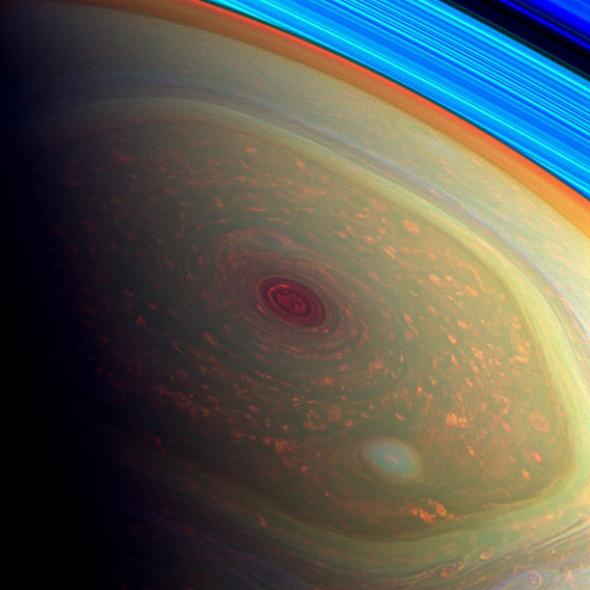Saturn’s Psychedelic Jet Stream
Saturn is a gas giant planet, nine times wider than Earth, and mostly atmosphere. We don’t see its surface as such, but the top of its clouds. That means we peer down on a wildly dynamic environment, in some ways like Earth and in others, well, alien.
And sometimes both. Sitting over the planet’s north pole is a vast circulation pattern of gas called the north polar vortex: 20,000 kilometers (12,000 miles) across, it forms a surprisingly regular hexagon, with winds and storms churning around inside it.
A new animated image above of the six-sided system was just released by astronomers, and is the first to show the motion of the vortex in color, and is the highest-resolution full view of it so far. We’ve seen spectacular shots of it before, but never the whole thing like this:
[Photo by NASA/JPL-Caltech/SSI/Hampton]
The images were taken by the Cassini spacecraft, which has been orbiting the ringed planet since 2004. In it you can see difference between the inside and outside of the hexagon; scientists can use these images to understand better what’s going on in Saturn’s complex atmosphere, including what material is in it, the sizes of the particles, and the temperatures of the gaseous constituents as well.
Incidentally, see that big whitish circle near the bottom of the vortex? That's a storm roughly 2000 km (1200 miles) across: comfortably larger than Texas. The huge hurricane in the very middle of the hexagon has also been seen in staggering detail before as well.
The hexagon looks freaky, but it’s actually not that surprising; we see similar things on Earth in our own jet stream (called Rossby waves). What I find most interesting is not that it exists at all but that it’s so symmetric and well-defined; on Earth it’s sloppier. Saturn spins far faster than Earth does (its day is about 10.5 hours long), so, coupled with its larger size, the Coriolis force is far larger there, helping define the vortex’s shape.
Images and animations like this help us understand what’s going on in that vast laboratory over a billion kilometers away. I am all for that; knowledge for its own sake is a wonderful thing. But we’re also trying better to understand our own planet, and it helps considerably to have something with which to compare and contrast it, even something seemingly so different. Inevitably with space science, looking out is very much the same as looking in. We try to understand the Universe so we can better understand our own environment.



